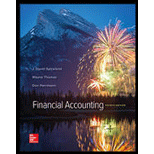
1.
Journal entry is a set of economic events which can be measured in monetary terms. These are recorded chronologically and systematically.
Accounting rules for Journal entries:
- To record increase balance of account: Debit assets, expenses, losses and credit liabilities, capital, revenue and gains.
- To record decrease balance of account: Credit assets, expenses, losses and debit liabilities, capital, revenue and gains.
To Record: Each transaction for Maintenance Services O.
2.
Accounting equation is the mathematical representation of the relationship among the assets, liabilities, and
To Indicate: The impact of each transaction on the accounting equation for each company.
Want to see the full answer?
Check out a sample textbook solution
Chapter 2 Solutions
FINANCIAL ACCOUNTINGLL W/CONNECT >IC<
- General accountingarrow_forwardWhat is the revised depreciation expense for 2019arrow_forwardIn 2009 Nitya Ltd. had a net profit of $100,000after charging an amortization expense of $50,000. Inventories had increased by $100,000 and accounts receivable had increased by $50,000 over the year. Accounts payable had remained constant at $250,000. Calculate the cash from operations.arrow_forward
- Principles of Accounting Volume 1AccountingISBN:9781947172685Author:OpenStaxPublisher:OpenStax College
 Intermediate Accounting: Reporting And AnalysisAccountingISBN:9781337788281Author:James M. Wahlen, Jefferson P. Jones, Donald PagachPublisher:Cengage Learning
Intermediate Accounting: Reporting And AnalysisAccountingISBN:9781337788281Author:James M. Wahlen, Jefferson P. Jones, Donald PagachPublisher:Cengage Learning  Financial Accounting: The Impact on Decision Make...AccountingISBN:9781305654174Author:Gary A. Porter, Curtis L. NortonPublisher:Cengage Learning
Financial Accounting: The Impact on Decision Make...AccountingISBN:9781305654174Author:Gary A. Porter, Curtis L. NortonPublisher:Cengage Learning



